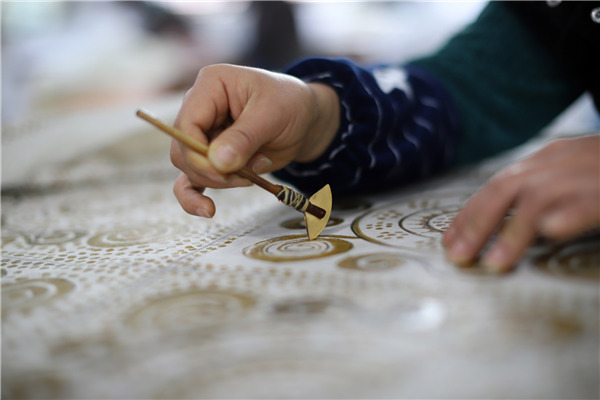Ethnic culture popularity grows on Chinese herb leaves
Xinhua | Updated: 2020-04-02 10:00

Zhang started learning about Miao wax dyeing when she was a little girl. Her role model was her mother.
"The Miao people's ethnic clothes were just so beautiful in my eyes, and I wanted to learn the skill well," she said.
People traditionally grow rhizoma et radix baphicacanthis cusiae in the county and have always used its leaves as pigment for their garment.
But for the little Zhang, it was no easy job.
"Extracting the indigo pigment was quite complicated," she said. "You have to grow the plants first." After reaping the plants, Zhang would soak the leaves in water, fetch the blue leaves, extract the indigo essence and make it into the sediment.
"I would carefully watch my mom do it," she said.
With the pigment, she could then proceed to wax dyeing.
"Wax dyeing also involves a number of procedures," she said. "First of all, you need to paint the wax on the cloth and soak the cloth material in the indigo pigment. The final product is not complete until you are done with oxidization, removing the wax and washing."
In 1998, Zhang graduated from junior school and left her hometown for better-paying jobs. After three years of a life adrift, she returned to her home county with some earnings and prepared to create a business of her own.
"I have always adored Miao clothes, so I decided that I wanted to do something about it," she said. "Then, I became a Miao clothes maker."
In 2013, Zhang established a Miao clothes processing store, which would evolve into her own company Gen Lan Mu Tu within two years, mainly focusing on Miao wax dyeing.
The products that the company churns out are Miao clothes with ethnic elements, including phoenixes, flowers, birds and Miao people playing the Lusheng, a reed-pipe wind musical instrument. All these pictures are wax dyed white, in contrast to the indigo background.
"Gen Lan Mu Tu is about making the world more colorful with plant-based wax dyeing," she said. "It is a green and healthy concept, and it helps promote our ethnic Miao culture."
The company has about 260 long-term employees for wax dyeing and embroidering. It has cooperated with local farmers in the plantation of rhizoma et radix baphicacanthis cusiae. Last year, locals planted 933 hectares of the herb.
























